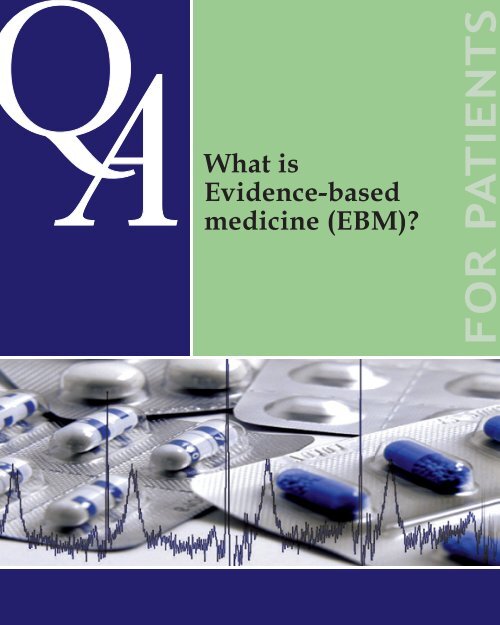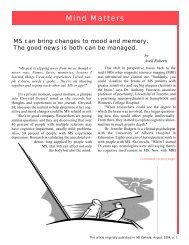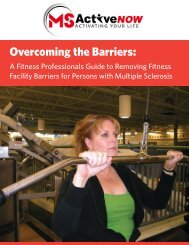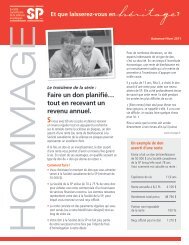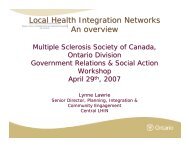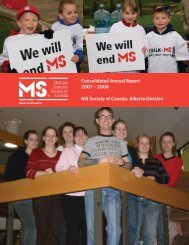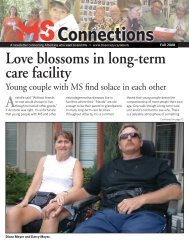Evidence-based medicine (EBM)
Evidence-based medicine (EBM)
Evidence-based medicine (EBM)
Create successful ePaper yourself
Turn your PDF publications into a flip-book with our unique Google optimized e-Paper software.
A<br />
What is<br />
<strong>Evidence</strong>-<strong>based</strong><br />
<strong>medicine</strong> (<strong>EBM</strong>)?<br />
FOR PATIENTS
Acknowledgements<br />
Written by:<br />
Martha Carmichael and Dr. Stan Kutcher<br />
© Copright 2008
What is <strong>Evidence</strong>-<strong>based</strong> <strong>medicine</strong><br />
(<strong>EBM</strong>)?<br />
<strong>Evidence</strong>-<strong>based</strong> <strong>medicine</strong> (<strong>EBM</strong>) is a term that has become widely used in health<br />
care settings. But, what exactly is <strong>EBM</strong> and what does it mean for you? <strong>EBM</strong> is<br />
“the conscientious, explicit, and judicious use of current best evidence in making<br />
decisions about the care of individual patients” (Haynes and Haines, 1996). The<br />
“best evidence” comes from the more than 20,000 scientifi c research studies that<br />
are published every year, and “patient care” involves everything from diagnosis to<br />
treatment.<br />
<strong>EBM</strong> is not just a recipe for treatment (e.g. every 15 year-old male with depression<br />
is not automatically prescribed the same medication). It is a methodical approach<br />
to patient care that is comprised of three components: the scientifi c evidence, the<br />
expertise of your health provider(s), and you. <strong>EBM</strong> “integrates the best external<br />
evidence with individual clinical expertise and patients’ choice” (Haynes and<br />
Haines, 1996) to ensure that patients receive the treatment that best meets their<br />
needs. <strong>Evidence</strong>-<strong>based</strong> <strong>medicine</strong> goes beyond treatments. It also applies to how<br />
patients are assessed, diagnosed, monitored, and followed over time.<br />
Reference: Haynes and Haines. 1996. Getting research fi ndings into practice: Barriers and bridges to evidence-<strong>based</strong><br />
clinical practice. BMJ. 312: 71-72.<br />
<strong>Evidence</strong>-<strong>based</strong> <strong>medicine</strong> and you<br />
When we are unwell, it is often diffi cult to tell what has caused the problem and what<br />
can best help. Imagine that you are ill for a few days with a sore throat and cough.<br />
When your condition improves, you might wonder what made you feel better. Was<br />
it the bedrest, the cold medication, the chicken soup, or was it simply giving your<br />
body enough time to fi ght off the illness? And what if your friend gave you a “secret<br />
remedy” made from milk, cognac and grass? Is that why you feel better?<br />
Before you spend time and money on a treatment, you might want the best<br />
information about whether the treatment works, how well it works compared to<br />
other treatments and what possible problems can result from the treatment. You<br />
should be aware of possible problems (such as the types of side effects that might<br />
happen, the cost of the treatment and the diffi culties in taking the treatment) that<br />
may occur when you and your health care provider are deciding which treatment<br />
you should have. (Note: a health care provider could be a doctor, nurse, psychologist,<br />
social worker, etc.).<br />
4
The ultimate goal of <strong>EBM</strong> is to help patients receive the treatment that is most<br />
appropriate for them. This means fi nding a balance between the scientifi c evidence,<br />
the patient’s values and the experience of their health provider(s). Remember,<br />
people can respond differently to any given treatment, so it is impossible to know<br />
exactly how you may respond. However, at least you can know what the chances<br />
are that you might be helped or harmed by a given treatment. This can help you,<br />
your doctor and other health providers come to a better decision about what<br />
treatment is right for you.<br />
<strong>Evidence</strong>-<strong>based</strong> patient choice is a very important part of evidence-<strong>based</strong><br />
health-care. It is important for patients to increase their knowledge about their<br />
health-care options, and for them to understand that not all of the information<br />
available (for example: on the internet, in books or in magazines) is equally<br />
correct. It is important to know whether the information you fi nd or are given is<br />
trustworthy, and to know the evidence for or against your treatment of choice.<br />
If you hear about a treatment being helpful or harmful, you should try to fi nd<br />
out where the information came from and whether or not it should be trusted.<br />
Health providers can help you with this.<br />
Remember, if you need medical advice, you should always seek the services of a<br />
competent health provider. Competent health providers can be those who are licensed<br />
by legally constituted regulatory bodies, such as doctors, nurses, psychologists, social<br />
workers, etc. It is much more diffi cult to determine the competencies of those persons<br />
who advertise their services outside of legally recognized regulatory bodies. Use such<br />
self-proclaimed “experts” at your own peril.<br />
Don’t assume you know everything about your problem or condition – even if<br />
you have looked up your symptoms on the internet or in a book. Diagnosing or<br />
treating yourself may turn out to cause more problems than you can predict. If<br />
you fi nd information you think is relevant to your condition, take a copy to your<br />
appointment and discuss what you have found with your health care provider.<br />
Making sense of media reports<br />
Hardly a day goes by without news reports about the latest medical research.<br />
Sometimes the media presents the story exactly as it is, and faithfully reports the<br />
fi ndings of a new study. Other times, the media sensationalizes, distorts or even<br />
misrepresents what the study actually found. Based on the news reports you have<br />
seen, it might surprise you to learn that scientifi c studies cannot prove anything<br />
with absolute certainty. Medical research is <strong>based</strong> on the concept of probability<br />
5<br />
FOR PATIENTS
(how likely it is that an event will or will not occur), and not on the concept of proof.<br />
For example, a recent study reported that 70 per cent of people who took the<br />
treatment improved substantially. These fi ndings give us an idea of the likelihood<br />
of improvement, but the fi ndings cannot predict with 100 per cent accuracy what<br />
will happen to any individual who takes the treatment. If a treatment is effective<br />
for seven out of 10 people, you still don’t know if it will work for you until you try<br />
it. However, if an alternative treatment works for nine out of 10 people, you may<br />
have a better chance of success with the alternative.<br />
That being said, we’re all familiar with the headlines – drug X causes cancer, food<br />
Y prevents dementia, activity Z induces weight loss. Perhaps these headlines<br />
should read “drug X might cause cancer in mice,” “food Y might help to prevent<br />
dementia in middle class Norwegians who are also taking aspirin” and “activity<br />
Z induces weight loss when combined with a healthy diet in some but not all<br />
people.”<br />
The truth is, most health information is incredibly complex. Reporters do not<br />
necessarily have the time to read and analyze entire research papers, and instead<br />
may rely on short press releases for their information. Further, some reporters<br />
may not have the knowledge or experience that they need in order to critically<br />
evaluate complex scientifi c information. Deciding which media reports to<br />
trust and which to question is not easy, especially because the reports are not<br />
consistent and sometimes seem contradictory. One day the headlines might<br />
read “Antidepressants increase suicide risk in teens” and the next, they read<br />
“Antidepressants lead to fewer, not more, teen suicides.”<br />
If you’re wondering about the validity of a news report, it might help to ask<br />
yourself a few questions about the story. Is the story actually an advertisement<br />
for something? Is it sensationalized to make a better selling story? Is there any<br />
background information provided that might help you evaluate it better? Does<br />
the story give you different points of view, or just one? Does the report provide<br />
expert opinion from people who were not involved in the study? If the report is<br />
particularly one sided (whether very positive or very negative), you should start<br />
to wonder if it is accurate. And, if the report does not give the study results in<br />
context or in statistical probabilities, it is a good idea to question the information<br />
provided.<br />
6
If you want to follow up on a media report, there are a few things you can do:<br />
1. Discuss the report with your health provider to determine if it is<br />
a scientifi cally valid study and if the information that it provides<br />
is relevant to you.<br />
2. Try to fi nd the source of the information. Is the information<br />
<strong>based</strong> on a high quality, unbiased study published in a reputable<br />
medical journal? Or is it <strong>based</strong> on a testimonial or another form<br />
of non-scientifi c information?<br />
3. Try to fi nd out if there is other collaborative information from<br />
independent sources (to avoid making important health decisions<br />
on single bits of information).<br />
4. Try to fi nd out what experts in the fi eld think of the new<br />
information. Sometimes studies can be controversial and not all<br />
research that is published is ultimately found to be correct.<br />
Making sense of websites<br />
Information found on websites is similar to that found in the media – it can<br />
be diffi cult to tell which websites to trust, and which to question. Also, not all<br />
information on a website is necessarily of the same level of scientifi c validity<br />
– there may be different types of information on the same website. Remember<br />
to ask yourself who is responsible for the website, who wrote the article you<br />
are reading, and what the original source is. Think about what the authors or<br />
organizations have to gain or lose. Websites that are created and maintained by<br />
credible organizations and that provide access to the original research studies<br />
on which they base their information tend to be more trustworthy.<br />
Be wary of blogs – they can be heavy on personal experience and light on scientifi c<br />
evidence. Generally, websites of not-for-profi t organizations and governments<br />
contain more reliable information than blogs and commercial sites. And, be<br />
very careful of commercial sites masquerading as not-for-profi t sites – trust<br />
organizations you know!<br />
Do your best to make sure the information is accurate, objective and trustworthy,<br />
but remember that this can be very diffi cult! Deciding what is worthy of believing<br />
and what is better ignored can be very diffi cult, even for experts. The information<br />
should be <strong>based</strong> on the highest quality research, and should be presented in an<br />
easy-to-understand fashion. Also, be careful that the information you are reading<br />
is up-to-date (on what date was the information added to the website?). Lastly,<br />
7<br />
FOR PATIENTS
eware of “health myths” – watch out for misleading words like “miracle,”<br />
“breakthrough,” and “all-natural.”<br />
Remember, if you have any questions that you can’t fi nd answers to, don’t be<br />
afraid to ask your health provider(s).<br />
What is meant by scientifi c evidence?<br />
(a) Types of research paper<br />
The scientifi c evidence used in <strong>medicine</strong> comes from a pool of tens of thousands<br />
of published research studies. There are many types of studies, and the design<br />
of any given study usually depends on the question that the researchers<br />
want answered. Studies can differ considerably in the way they are designed<br />
and conducted, and can therefore differ considerably in quality. Studies that<br />
stringently adhere to scientifi c research principles tend to be given more<br />
credibility than studies with more relaxed methods, but all study types have<br />
their own unique advantages and disadvantages.<br />
Scientifi c evidence is hierarchical in nature, with study design (the way in which<br />
a study is developed and conducted) being an essential component of where the<br />
results of a study sit on the hierarchy. Study designs near the top of the hierarchy<br />
(for example: Randomized Clinical Trials – also known as RTCs) are less likely to<br />
report misleading or incorrect fi ndings than those lower down on the hierarchy.<br />
The following is the agreed upon hierarchy of scientifi c evidence from the bottom<br />
(least robust evidence) to the top (most robust evidence):<br />
Case reports g Case series g Cross-sectional surveys g Retrospective<br />
comparative studies g Prospective comparative studies g Randomized<br />
clinical trials (RCTs) Systematic reviews of RCTs<br />
8
Clinical decisions are usually <strong>based</strong> on studies at the top of the hierarchy (i.e. randomized<br />
clinical trials and systematic reviews), but the information from other types of study is<br />
not useless – it all contributes to the general knowledge on a given topic, and might<br />
inform future research that employs more stringent scientifi c methods.<br />
1. A case report is a report about one patient. For example, a case report could<br />
describe a patient whose medical problem was successfully treated by a<br />
novel treatment.<br />
2. A case series is a report on several patients. For example, a case series may<br />
report on an unexpected side effect experienced by several people taking<br />
the same medication.<br />
3. A cross-sectional study looks at one or more health problems in a group<br />
of people at any one time. Health surveys are common examples of crosssectional<br />
studies.<br />
4. Retrospective comparative studies (e.g. case-control studies) look back in<br />
time to determine the association between a specifi c health problem and<br />
what may be causing it or helping it. There are two or more groups in these<br />
studies, the people who have the health problem and the people who<br />
don’t. The researchers then try to determine what factors predict who gets<br />
and who doesn’t get the health problem. For example, people who have<br />
broken hips may be more likely to have used a certain type of medication<br />
than people who don’t have broken hips, suggesting that the medication<br />
may increase the risk for hip fractures.<br />
5. Prospective comparative studies (e.g. cohort studies) look forward in time.<br />
Two or more groups are selected, <strong>based</strong> on their exposure to something<br />
(for example a medication, a living environment or a past illness). At a later<br />
point, the groups are evaluated for a specifi c health problem. For example,<br />
researchers may wonder if a specifi c type of sleeping pill increases the<br />
risk of falls and hip fractures. Starting with a large group of people, they<br />
can study them over a period of years to see if more people taking the<br />
medication experience falls and hip fractures than those not taking the<br />
medication.<br />
None of the above types of studies (case report, case series, cross-sectional<br />
study, retrospective comparative study) can be used as evidence to support (or<br />
refute) a particular treatment or a particular hypothesis about what causes a<br />
specifi c disorder or problem. However, they can be used to create ideas about<br />
what might be an effective treatment or what might cause a specifi c disorder.<br />
9<br />
FOR PATIENTS
These ideas can then be tested by other more scientifi cally valid studies, which<br />
are described below.<br />
6. Randomized controlled trials (RCTs) are another type of prospective<br />
comparative study, but with one important difference. People in these<br />
studies are randomly allocated to a treatment or other condition by the<br />
researchers. In cohort studies, the researchers do not intervene. They<br />
simply observe what happens under “normal” circumstances, which has<br />
its advantages and disadvantages. A major disadvantage is that it can be<br />
very hard to compare people who get a certain treatment with people who<br />
do not get that treatment, even if they have the same diagnosis. The people<br />
who did not get the treatment may have a higher risk for a problem with<br />
the treatment. For example, when studied under normal use, a medication<br />
may not appear to cause hip fractures. However, the reason for this could<br />
be that doctors avoid giving the medication to people who are unsteady<br />
on their feet and are at higher risk for hip fractures, but they do give it to<br />
people a low risk for hip fractures. So, the reason the medication appeared<br />
safe is because it was given to a group of people at low risk of hip fracture<br />
and they had the same rate of hip fractures as people at high risk. In<br />
essence, the medication changed the low risk group to a high-risk group<br />
but this study design would not be adequate for determining this.<br />
To get around this problem, randomized controlled trials have become the<br />
best way to measure the safety and effectiveness of medications and other<br />
medical treatments. Randomization means that people are allocated by chance<br />
to one of two or more different treatment groups and they have an equal<br />
chance of being put into any one of the groups. This helps to ensure that the<br />
groups are equal at the start of the treatment (i.e., they are at the same risk of<br />
having a good or a bad outcome during treatment). If a difference in outcomes<br />
is then found across groups, it is much safer to conclude that the difference is<br />
attributable to the treatment.<br />
7. A systematic review is a special type of evaluation of many selected studies<br />
that have been conducted on a certain topic. For example, a researcher<br />
might gather and evaluate all of the high quality RCTs involving treatment<br />
of anxiety with selective-serotonin-reuptake inhibitors (SSRIs). These<br />
studies are sometimes called meta-analyses because of the statistical<br />
method used to combine the selected studies.<br />
10
(b) Parts of a research paper<br />
Although studies vary greatly in design, authors tend to stick to a fairly rigid format<br />
when publishing the results of their studies. Published papers are broken into fi ve<br />
sections, and the content of each section is quite invariable across the board.<br />
1. The abstract is an overview or summary of the entire study (i.e.<br />
objective or purpose, methods, results, conclusions).<br />
2. The introduction states the purpose or objective of the study, in the context<br />
of what is already known about the topic. It describes why the researchers<br />
are asking the question, and why the question is an important one.<br />
3. The methods section describes exactly how the study was conducted,<br />
and in great detail. It includes information on the study design,<br />
participants and procedures.<br />
4. The results section is a summary of the data that was collected and the<br />
statistical signifi cance of the fi ndings (i.e. how sure the researchers are<br />
that their results are accurate).<br />
5. The discussion/conclusions section includes the authors’ explanation<br />
of and interpretation of the results. This often includes whether or<br />
not the expected result was obtained, how the results fi t with those of<br />
previous studies, and suggestions for future studies.<br />
Best evidence informs patient care<br />
As you know, not all scientifi c evidence carries equal weight – some research<br />
is more likely to be valid than other research. The validity of scientifi c studies<br />
depends on many factors, including the type of study conducted, the statistical<br />
analyses used and the rigour of the external independent review of the results.<br />
However, whatever the study design or statistical analysis, all therapeutic<br />
studies conducted in universities or hospitals, and all those that receive any<br />
federal funding must be approved by a research ethics board before the study<br />
begins. This process helps ensure that the participants of the study are suffi ciently<br />
protected, and that the research meets the highest ethical standards.<br />
(a) Randomized controlled trials<br />
The best evidence for safe and effective treatments comes from clinical trials (also called<br />
11<br />
FOR PATIENTS
clinical studies, controlled clinical trials, or randomized controlled trials). In the case of<br />
treatment, this research tells us whether a particular treatment is likely to work, how<br />
well it works compared to other treatments, and what the risks of the treatment are.<br />
The study participants (often patients) are divided randomly into two or more<br />
groups. One of the groups is given the experimental treatment and the other<br />
is given either an alternative treatment (a previously established and known<br />
effective treatment) or a placebo treatment. Placebo treatments use “inert”<br />
compounds, which have no direct therapeutic effects. The key is that the<br />
participants must be divided into groups absolutely randomly, to ensure that<br />
the groups are comparable right from the start and that the only difference<br />
between the groups is the treatment.<br />
At the end of the study, the differences in outcomes between the groups<br />
(both therapeutic outcomes and unwanted outcomes such as side effects) are<br />
statistically analyzed from group data. Predetermined acceptable levels of<br />
probable outcomes (that is, outcomes that are less likely due to chance alone)<br />
help guide the interpretation of the study results.<br />
Although clinical trials all follow the same basic framework, the details can<br />
differ considerably between trials (e.g. length of study, number of participants<br />
enrolled in the study, etc.). Sometimes a study involving 50-100 people and<br />
spanning a week or two is suffi cient, but sometimes many thousands of people<br />
need to be included and followed for many years. For long-term chronic diseases<br />
(e.g. cancer, diabetes, schizophrenia, etc.), many people need to be studied for<br />
long periods of time in order to reveal useful information about what is the<br />
best treatment approach. Studies with large numbers of participants often (but<br />
defi nitely not always) provide stronger evidence than studies with small numbers<br />
of participants.<br />
(b) The preponderance of evidence<br />
Medical treatments are built on the preponderance of scientifi c evidence. The<br />
treatments with the highest levels of validity (the most certainty that they are<br />
effective and safe) are those on which large numbers of clinical trials have been<br />
conducted in different settings and in different types of patients and in which<br />
the results are generally similar.<br />
12
Remember that not all studies necessarily come to the same conclusion. For<br />
example, eight studies of treatment “X” could show that it is safer and more<br />
effective than treatment “Y” while two more studies could show the opposite.<br />
The preponderance of evidence is then addressed using special statistical<br />
techniques (i.e. meta-analysis, described above). Meta-analyses (often provided<br />
as systematic reviews) then provide guidance on which treatment is more likely<br />
to be safe and effective.<br />
(c) Systematic reviews<br />
This type of analysis is very important, because rarely does a single trial provide<br />
strong enough evidence to offer a reliable answer to a health care question.<br />
Unfortunately, for many reasons (too few participants, non-random distribution<br />
into groups, lack of a placebo treatment, etc.) the results of individual studies<br />
can be misleading or incorrect. Sometimes single studies are overly optimistic<br />
about a treatment, and sometimes they are overly pessimistic – in either case, the<br />
results of fl awed studies invariably provide bad evidence. Accordingly, patient<br />
care decisions are rarely made <strong>based</strong> upon the results of a single study. Best<br />
evidence in <strong>medicine</strong> comes from careful consideration of the results of all trials<br />
that have been conducted on a given subject. For treatment or therapy questions,<br />
a systematic review is the highest level of evidence possible.<br />
Systematic reviews are diffi cult and time-consuming to conduct, because they<br />
must be thorough and comprehensive – not only must the authors fi nd all of the<br />
trials on the subject in which they are interested, they must then carefully evaluate<br />
and quality-assess every one of those trials (i.e. often hundreds of trials). Trials<br />
should only be included in a systematic review if they meet specifi c pre-defi ned<br />
criteria, and if they are of good quality. By considering the results of all of the highquality<br />
trials and disregarding the others, systematic reviews yield an overview of<br />
the state of medical knowledge on the subject of interest.<br />
Because the technique is a relatively new one, there are many topics that have<br />
not yet been systematically reviewed. And in some cases, even when a topic is<br />
systematically reviewed, there might not be enough good quality evidence to<br />
provide a solid answer to the question being asked. Older systematic reviews<br />
sometimes included studies that were not of the highest quality, so their results<br />
may have been affected by that fact. Today, systematic reviews provide the reader<br />
with more sophisticated methods that help readers evaluate the probability that<br />
certain treatments are safe and effective.<br />
13<br />
FOR PATIENTS
Practice guidelines<br />
It is diffi cult for physicians to search the literature and critically evaluate the<br />
studies that they fi nd every time they need to make a treatment decision. For<br />
this reason, groups of experts compile the evidence so that physicians do not<br />
have to. Expert committees review the literature, decide how it should infl uence<br />
patient care, and then distribute recommendations in the form of evidence<strong>based</strong><br />
practice guidelines. Recommended interventions are often categorized<br />
as “Best-supported (Well-established) interventions” or “Promising (Probably<br />
effi cacious) interventions” <strong>based</strong> on the strength of the evidence.<br />
Where can I fi nd research papers?<br />
(a) Online databases<br />
Online databases allow individuals to search through millions of research articles<br />
quickly. However, because many journals are not available free of charge, you might not<br />
always be able to access the full-text article through these databases. One way to solve this<br />
problem is to go to a public library, hospital library or university library. Many libraries<br />
have print and/or online subscriptions to journals, and this might allow you to access<br />
articles that you cannot access from home. However, even when the full-text version is not<br />
available, you will usually be able to read a free summary (abstract) of the article.<br />
PubMed and PubMed Central<br />
www.pubmed.gov and www.pubmedcentral.nih.gov<br />
These databases (from the US National Institutes of Health)<br />
provide free abstracts from thousands of journals, as well as links<br />
to some free full-text articles.<br />
Cochrane Database<br />
www.cochrane.org<br />
The Cochrane Collaboration conducts systematic reviews of the<br />
effects of healthcare interventions. Abstracts and plain language<br />
summaries are available.<br />
HighWire Press<br />
http://highwire.stanford.edu<br />
This database (a division of the Stanford University Libraries)<br />
14
includes almost fi ve million articles, two million of which are<br />
provided free of charge.<br />
MedlinePlus<br />
www.nlm.nih.goc/medlineplus<br />
MedlinePlus provides authoritative information from the US National<br />
Library of Medicine and the US National Institutes of Health. It<br />
provides easy access to journal articles, information about drugs, a<br />
medical encyclopedia, patient tutorials and the latest health news.<br />
(b) Open-access journals<br />
Some research papers are available free of charge in journals called open-access<br />
journals. These journals are peer-reviewed like other journals, but are available<br />
online and free of charge.<br />
Open Medicine<br />
www.open<strong>medicine</strong>.ca<br />
Open Medicine is a Canadian independent, peer-reviewed, open-access<br />
journal. Full articles are provided free of charge to the general public.<br />
PLoS Medicine<br />
http:<strong>medicine</strong>.plosjournals.org<br />
PLoS Medicine is a peer-reviewed, open-access journal (from the<br />
Public Library of Science). Full articles are provided free of charge<br />
to the general public.<br />
Questions to ask<br />
When you have found a study, ask yourself these questions to determine whether<br />
or not the results of the study might apply to you or your family members.<br />
1. What kind of study is it?<br />
What is the study design? Where does it fi t on the evidence hierarchy? Does it<br />
provide strong evidence or weak evidence? Remember, for clinical decisions,<br />
randomized clinical trials and systematic reviews provide the best evidence.<br />
2. Was the study conducted on animals or humans?<br />
Research conducted on humans is more likely to apply to you than<br />
research conducted on animals.<br />
3. Did the study include people like you?<br />
Check to see if the study participants were similar to you in age, sex,<br />
15<br />
FOR PATIENTS
educational level, ethnocultural background, diagnosis and health<br />
concerns. The results of studies that were conducted on people who are<br />
very different from you might not apply to you.<br />
4. Is the study published in a peer-reviewed journal?<br />
In peer-reviewed journals, an independent panel of experts reviews<br />
every article before it can be accepted for publication. For this reason,<br />
research that is published on a website or in a brochure is less believable<br />
than research that is published in a peer-reviewed medical journal.<br />
5. Who funded the study?<br />
Knowing who paid for the study and what stood to be lost or gained from<br />
the results is very important. People or organizations that fund studies<br />
sometimes stand to make or lose money from positive or negative study<br />
results (e.g. if a study was funded by a company who make and sell the<br />
study treatment, a positive result would benefi t the company fi nancially).<br />
Studies funded by independent agencies may be less biased.<br />
6. How many people participated in the study?<br />
Generally, the larger the number of participants in a well-designed and wellconducted<br />
study, the more confi dence we can have in the results (but, this is not<br />
always true). Also check how many people dropped out of the study (“withdrew”<br />
were “lost to follow up,” etc.) - high drop out rates can weaken the results.<br />
7. Do the authors discuss clinical signifi cance?<br />
The authors of research studies always discuss statistical signifi cance<br />
– that is, whether the observed result is probably real or whether it<br />
could have occurred by chance. However, clinical signifi cance is another<br />
concept altogether. Clinical signifi cance refers to whether the observed<br />
result will make any real difference in the lives of patients. For example,<br />
a given drug could decrease blood pressure by two points (and this result<br />
could be statistically signifi cant), but that two-point difference might not<br />
noticeably improve a patient’s condition.<br />
8. Who conducted the study and where?<br />
Check to see that at least one of the authors is an expert in the fi eld, and<br />
16
that the authors are affi liated with reputable universities, hospitals or<br />
research institutions. Be careful of authors without any clear affi liations.<br />
9. Is there more than one side to the story?<br />
Find out whether or not the results have been replicated by other<br />
researchers. A new study that is consistent with previous high-quality<br />
studies is more convincing than one that is not. If the new study is the<br />
fi rst of its kind, more research will be needed to confi rm the result.<br />
Further, when authors report on controversial topics, they should include<br />
a discussion of the “other side” of the argument in their paper.<br />
Communicating with your<br />
healthcare provider<br />
In the past, doctors gave orders and patients followed them; now, the patientdoctor<br />
relationship is more of a partnership. Patients and their families work as<br />
a team with physicians and other health care professionals to alleviate problems<br />
and to ensure the best care possible. What’s your role in this partnership?<br />
Whether the patient is you, a friend or a family member, your role is to be<br />
informed, ask questions and express any concerns that you may have. Be<br />
informed about the illness and available treatments, ask questions if your<br />
healthcare provider’s explanations are unclear, and express your concerns (even<br />
if you are not explicitly asked about them).<br />
Appointments with your health care provider are a wonderful opportunity to<br />
ask questions and clarify issues, however, feeling rushed or stressed can make<br />
it easy to forget some of the topics you wanted to cover. Preparing for your<br />
appointment can help you get the most out of the experience.<br />
Arrive early so that you can spend as much time as possible with your healthcare<br />
provider. Bring a list of concerns and questions, and a list of all the prescription<br />
and over-the-counter medications, herbals and vitamins that you are taking. Bring<br />
a pen and a piece of paper to take notes during the appointment, and make sure<br />
to copy down your healthcare provider’s instructions. If you think it would be<br />
helpful, bring a friend or family member along to take notes and ask questions<br />
on your behalf. Most importantly, keep asking questions until you understand<br />
your diagnosis and what you need to do to get well.<br />
Asking very specifi c questions might help your healthcare provider break<br />
complicated information into easy to understand chunks, and might help you<br />
and your healthcare provider communicate better.<br />
17<br />
FOR PATIENTS
Diagnosis:<br />
• What do you think my diagnosis is?<br />
• What else could it be?<br />
• What does this mean for my day-to-day life? For my future?<br />
• What do I need to do to get well?<br />
• Where can I get more information about my condition?<br />
Treatment options:<br />
• What are my treatment choices?<br />
• What kinds of studies have been done on these treatments?<br />
• What are the benefi ts and risks of each treatment?<br />
• How likely is each treatment to help me?<br />
Medication:<br />
• What does this <strong>medicine</strong> do to my body?<br />
• What are the alternative <strong>medicine</strong>s and why are you recommending<br />
this one over the others?<br />
• What kinds of studies have been done with this medication?<br />
• What other <strong>medicine</strong>s or treatments has it been compared to?<br />
• How likely is this <strong>medicine</strong> to help a person like me?<br />
• What are the risks and benefi ts of this medication?<br />
• Will the <strong>medicine</strong> interact with anything I am already taking?<br />
• What are the potential side effects? Will they fade over time?<br />
• When can I expect to see results?<br />
• How will I know if this medication is working for me?<br />
• How long will I have to take the <strong>medicine</strong>?<br />
• What will happen if this medication does not work for me?<br />
• What is the number needed to treat (NNT) of this drug? What is the<br />
number needed to harm (NNH) of this drug? (See the glossary for<br />
the defi nitions of these terms)<br />
Psychological treatments (therapy):<br />
• How will this therapy help me?<br />
• What are the alternative therapies and why are you recommending<br />
this one over the others?<br />
18
• What kinds of studies have been done with this therapy?<br />
• What other treatments has this therapy been compared to?<br />
• How likely is this therapy to help a person like me?<br />
• What are the risks and benefi ts of this therapy?<br />
• What are the potential side effects of this therapy? Have studies<br />
assessed possible side effects?<br />
• When can I expect to see results?<br />
• How will I know if this therapy is working for me?<br />
• How long will I need to continue the therapy?<br />
• What will happen if this treatment does not work for me?<br />
• What is the number needed to treat (NNT) of this treatment? What<br />
is the number needed to harm (NNH) of this treatment? (See the<br />
glossary for the defi nitions of these terms)<br />
Child and adolescent mental health<br />
<strong>Evidence</strong>-<strong>based</strong> <strong>medicine</strong> is extremely important in the treatment of mental<br />
illness in general, and is particularly important in the treatment of mental<br />
illness in children and adolescents. Children and adolescents often present with a<br />
complexity of problems that should be addressed when planning treatment (e.g.<br />
youth who present with mental disorders such as Attention Defi cit Disorder may<br />
also demonstrate learning disabilities or behavior problems).<br />
Treatment decisions should be <strong>based</strong> on the appropriateness of the treatment<br />
for a specifi c mental disorder, the appropriateness for specifi c symptoms, the<br />
appropriateness when compared to other treatments, and the youth/family’s<br />
acceptance of the treatment. Fortunately, the treatments available for children and<br />
adolescents with mental disorders are many and varied. Unfortunately, very few<br />
have been adequately evaluated for effi cacy in this population. There are many gaps<br />
in the scientifi c literature, and the research that does exist varies greatly in quality.<br />
It is important for young people and their parents to know which treatments<br />
have the best evidence to support their use. As a “rule of thumb”, it is usually<br />
better to use a treatment that has evidence from randomized controlled trials to<br />
support it over trials that have less rigorous evidence to support them. However,<br />
it is also important to remember that “absence of evidence is not evidence of<br />
absence.” It could be that the best treatment for you or your child may not<br />
have yet been subjected to the highest standards of scientifi c evaluation. This<br />
is another reason why it is essential to have an informed discussion with your<br />
healthcare provider – to fi nd out not only what the best evidence is, but to jointly<br />
decide on what the best treatment for you might be.<br />
19<br />
FOR PATIENTS
G lossary<br />
Adverse reaction/effect<br />
• a harmful or unpleasant reaction resulting from the use of a treatment<br />
• adverse reactions/effects prtedict risk upon future administration, and<br />
warrant withdrawal or alteration of the treatment<br />
Adverse effect<br />
• a harmful or unpleasant reaction resulting from any intervention (not just<br />
medication)<br />
• predicts risk upon future administration and warrants withdrawal of the<br />
treatment or alteration of the dosage regimen<br />
Bias<br />
• the presence of systematic error in a study (error that does not occur by<br />
chance)<br />
• bias can occur at any point in a study (study design, data collection, data<br />
analysis, etc.), and is the result of researcher error<br />
• bias undermines the validity of the study results<br />
Blinding<br />
• a method used to minimize bias (i.e. systematic error) in research<br />
• when blinding is used, information about which group participants have<br />
been assigned to (i.e. treatment group or placebo group) is concealed<br />
from participants and/or the researchers<br />
• single blind: information is concealed from the participants<br />
• double blind: information is concealed from the participants and the<br />
researchers<br />
Case-control study<br />
• a type of study that looks backward in time (i.e. retrospectively) at<br />
participants’ exposure to a potential risk factor<br />
• these studies compare the exposure of participants who have a disease<br />
(cases) to the exposure of non-diseased participants (controls)<br />
Case report<br />
• a report on a single patient with an outcome of interest<br />
Case series<br />
• a report on a series of patients with an outcome of interest<br />
21<br />
FOR PATIENTS
Clinical trial<br />
• a research study that tests a treatment (drug or other therapy) for<br />
effectiveness, safety and tolerability<br />
• these studies involve at least two groups of participants – one group<br />
receives the experimental treatment, and the other group receives either<br />
a previously established effective treatment, a placebo treatment or no<br />
treatment at all<br />
• clinical trials are also called controlled clinical trials (CCTs) or randomized<br />
controlled trials (when patients are randomly assigned to treatment and<br />
comparison groups)<br />
Clinical practice guideline<br />
• a systematically developed, evidence-<strong>based</strong> statement that is designed<br />
to advise the decisions of health care professionals and patients about<br />
appropriate health care<br />
Cohort study<br />
• a type of study that looks forward in time (i.e. prospectively) for<br />
participants exposure to potential risk factors and for an outcome of<br />
interest<br />
• these studies compare the outcomes of participants who were exposed to<br />
a potential risk factor to those of participants who were not exposed<br />
Confl ict of interest<br />
• occurs when the researchers involved in a study have fi nancial,<br />
professional or other interests that could affect the design, conduct or<br />
reporting of the research<br />
• includes “actual” and “potential” confl icts, and arises when the outcome<br />
of the research can benefi t or harm the researchers in some way<br />
• remember to check the “confl ict of interest” statements in the research<br />
papers you read – researchers should disclose any actual or potential<br />
confl ict of interest<br />
Control Group<br />
• one of the groups of participants in a study<br />
• this group may receive either a standard (or previously demonstrated<br />
effective) treatment or a placebo treatment (an inactive substitute)<br />
22
• this group is compared to the experimental group (which receives a new<br />
treatment), to measure the effectiveness of the treatment<br />
Crossover study design<br />
• a type of study in which more than one treatment is administered to the<br />
same group of participants in a successive fashion<br />
• two problems can occur: carry-over effects (the effect of one treatment<br />
carries over into the second treatment period) and order effects (the order<br />
in which the treatments are administered may affect the outcome)<br />
Cross-sectional study<br />
• a type of study in which a population is observed over a specifi c time interval<br />
or at a single point in time (often referred to as a “snapshot” study)<br />
• the participants’ exposure to potential risk factors and development of<br />
the outcome of interest are determined simultaneously<br />
Double blind<br />
• studies in which neither the participants nor the researchers know the<br />
group (control or experimental) to which the participants were allocated<br />
(until the end of the study)<br />
Effect size<br />
• the estimate of the magnitude of the observed effect in a study<br />
• generally, the larger the effect size, the greater the effect of the treatment<br />
Epidemiologic Studies<br />
• studies that look at the percentage of people who are affected by a<br />
particular outcome of interest (e.g. disease, disorder, occurrence, etc.)<br />
Epidemiology<br />
• the study of the distribution, determinants and deterrents of morbidity<br />
(illness) and mortality (death)<br />
• that is, the study of who gets sick or dies, where they get sick or die, and<br />
when they get sick or die (distribution), what causes people to get sick or<br />
die (determinants) and what prevents these outcomes (deterrents)<br />
Experimental group<br />
• one of the groups of participants in a study<br />
• this group receives the new treatment that is being studied<br />
• this group is compared to the control group (which receives a placebo<br />
or a previously established effective treatment) in order to measure the<br />
effectiveness of the new treatment<br />
23<br />
FOR PATIENTS
Gold standard<br />
• a method, procedure or measurement that is widely accepted as being<br />
the best available<br />
• other methods, procedures or measurements are often compared to the<br />
gold standard<br />
Incidence<br />
• the number of new cases of a disease/disorder that arise during a<br />
specifi ed time period<br />
• incidence can be expressed as an incidence rate (i.e. the number of new cases<br />
that arise in a defi ned population over a specifi ed time period), or as an<br />
incidence proportion (i.e. the proportion of the people “at risk” in a defi ned<br />
population who will become new cases over a specifi ed time period)<br />
Informed consent<br />
• participants are informed about all aspects of the study (purpose, procedure,<br />
risks, benefi ts, etc.) before deciding whether or not participate in the study<br />
Longitudinal study<br />
• a type of study in which a population is observed at more than one point<br />
in time, so that the researchers follow the participants forward in time<br />
Meta-analysis<br />
• a type of study that combines the results of individual studies into one<br />
result to get an overall view of the effectiveness of a treatment<br />
• assuming the methodology is sound, they provide very good evidence<br />
for or against a given treatment<br />
Number needed to treat (NNT)<br />
• the number of patients who would need to be treated with the experimental<br />
treatment in order to achieve the desired outcome in one patient<br />
Number needed to harm (NNH)<br />
• the number of patients who would need to be treated with the experimental<br />
treatment in order to achieve a harmful outcome in one patient<br />
• the defi nition of harmful outcome depends on the treatment, and can<br />
range in severity from an unwanted side effect to death<br />
24
Observational study<br />
• a study in which participants are observed (or outcomes are measured)<br />
without any intervention by the researchers<br />
• no attempt is made to affect the outcome (no treatment or intervention is<br />
given to participants)<br />
• changes or differences in one variable (e.g. whether someone smoked) are<br />
studied in relation to changes or differences in another (e.g. whether they died)<br />
Odds<br />
• using odds is one way to express the likelihood of an event (another way<br />
to express likelihood is using probability)<br />
• the odds of an event are calculated by comparing the probability that an<br />
event will occur to the probability that the event will not occur<br />
• for example, if four out of fi ve patients achieve complete remission of<br />
symptoms after the administration of a given medication, the odds of full<br />
remission would be four to one<br />
• therefore, the odds of an event that is certain to happen are infi nity and<br />
the odds of an impossible event are zero<br />
P-value<br />
• expresses the probability that the results of a study (or results even more<br />
extreme) could have occurred by chance<br />
• p-values range from zero to one<br />
• the p-value helps determine whether the results are statistically<br />
signifi cant or not (the convention is that if p ≤ 0.05 the result is statistically<br />
signifi cant, but sometimes a more stringent criterion of p ≥ 0.01 is used)<br />
Placebo<br />
• a sham, fake, or inactive treatment/intervention received by the<br />
participants in the control group<br />
- indistinguishable from the active treatment or intervention received by<br />
participants in the experimental group<br />
Practice guideline<br />
• a systematically developed statement designed to help clinicians and patients<br />
make decisions about appropriate health care for specifi c clinical situations<br />
• expert committees review the scientifi c literature, decide how it should<br />
infl uence patient care, and then distribute recommendations in the form<br />
of evidence-<strong>based</strong> practice guidelines<br />
Prevalence<br />
• the total number of existing cases of a disease/disorder in a defi ned<br />
25<br />
FOR PATIENTS
population over a specifi ed time period<br />
• can be expressed as a prevalence rate (proportion of a defi ned population<br />
with a disease over a specifi ed time period), or as point prevalence<br />
(proportion of a defi ned population known to have the disease/disorder<br />
of interest at a particular point in time)<br />
Probability<br />
• using probability is one way to express the likelihood of an event (another<br />
way to express likelihood is using odds)<br />
• probability is the chance of an event occurring, and is expressed as the the number<br />
of actual occurrences divided by the total number of possible occurrences<br />
• probability is expressed as a decimal between 0 and 1<br />
• for example, if four out of fi ve patients achieve complete remission of<br />
symptoms after the administration of a given medication, the probability<br />
of full remission would be four divided by fi ve, or 0.8<br />
Prospective study<br />
• a type of study that follows participants forward in time<br />
• participants are exposed (or not exposed) to an intervention of interest, and then<br />
observed over time to determine how effective (or safe) the intervention is<br />
Randomization<br />
• when a randomization procedure is employed, the participants in a study<br />
are assigned to groups randomly<br />
• this means that every participant has an equal chance of being in the<br />
treatment group or in the control group<br />
• this procedure assures that any differences in outcomes between the<br />
groups are due to the treatments alone and not to other factors<br />
Randomized controlled clinical trial<br />
• a study in which participants are randomly assigned into at least two<br />
groups, an experimental group and a control group<br />
• the experimental group receives the new treatment, and the control<br />
group receives the standard treatment (a previously established effective<br />
treatment) or a placebo treatment<br />
• these studies demonstrate whether the treatment works, its risks and how<br />
well it works compared to other treatments<br />
26
Retrospective study<br />
• a type of study that looks backward in time in order to determine whether<br />
there is an association between an outcome of interest and an exposure<br />
(which may be causing or helping the outcome)<br />
• these studies include two or more groups of participants – the people who<br />
have the outcome of interest (often a health issue) and the people who do<br />
not<br />
• using these studies, researchers try to determine what factors predict who<br />
gets and who does not get the outcome of interest<br />
Risk factor<br />
• anything that increases a person’s chances of getting an illness (can be<br />
aspects of a person’s health, lifestyle or environment)<br />
• remember, risk factors increase a person’s chances of getting an illness – they<br />
do not cause the illness<br />
Safety<br />
• the potential of a treatment or therapy to cause serious adverse effects<br />
Systematic review<br />
• a systematic evaluation of many highly selected studies that have been<br />
conducted on a certain topic<br />
• is sometimes called a meta-analysis because of the statistical method<br />
used to combine the selected studies<br />
Single blind<br />
• studies in which the participants do not know the group (control or<br />
experimental) to which they have been allocated (until the end of the study)<br />
Tolerability<br />
• the potential of a treatment or therapy to cause unpleasant adverse effects<br />
• these effects are not medical emergencies, but can affect quality of life<br />
and willingness to continue the treatment<br />
Variable<br />
• a measure that can vary within a study<br />
• can refer to participant characteristics (age, sex, etc.) or to the main<br />
variables of the study (i.e. those that are controlled/manipulated by the<br />
researchers like medication type or dose, and those that are measured by<br />
the researchers to try to gauge the effect of the treatment, like resolution<br />
of symptoms or appearance of side effects)<br />
27<br />
FOR PATIENTS


